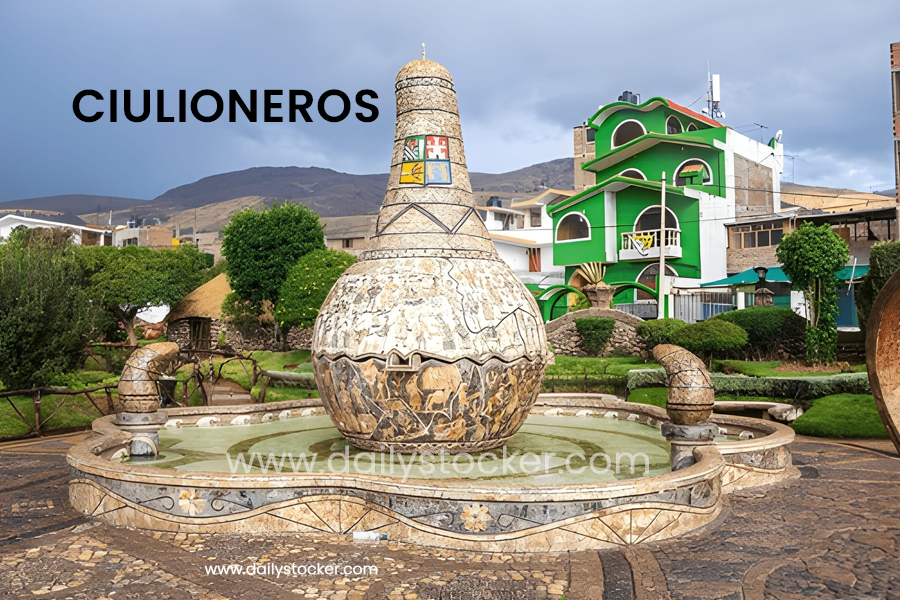Ciulioneros: A Living Heritage of Art, Identity, and Storytelling
What Are Ciulioneros?
At its core, ciulioneros refers to a vibrant cultural tradition and community known for preserving stories, artistry, and identity through creative expression. The term doesn’t just describe a people or place; it embodies an entire worldview — one that values connection, heritage, and continuity. In the world of cultural anthropology and creative arts, ciulioneros stands as a symbol of how tradition and innovation coexist in harmony.
When someone asks, “What are ciulioneros?”, the most direct answer is: they are the keepers of a timeless narrative. This community transforms memory into art — whether through masks, dance, music, or oral tales. Every story told within ciulioneros society acts as a vessel of shared wisdom, carrying forward the experiences of ancestors while reflecting the hopes of a new generation.
Far from being a relic of the past, ciulioneros culture thrives in the modern era. It adapts, evolves, and resonates globally, offering a powerful example of how cultural identity can flourish even amid rapid change. From their festivals to their artistry, every expression of this tradition reminds the world that creativity is not merely an act — it is a legacy.
The Historical Roots of Ciulioneros
The origins of ciulioneros are deeply intertwined with the ancient communities that once populated the region’s hills, valleys, and rivers. Early records — both oral and written — describe them as storytellers, artisans, and cultural mediators. They lived close to the land and developed rituals that honored nature’s cycles, human relationships, and the spirit of craftsmanship.
Through the centuries, ciulioneros became a bridge between neighboring cultures. Their openness to exchange led to a rich blend of influences — from indigenous symbolism to external artistic innovations brought through trade and migration. Yet, despite these interactions, the core values of the community remained intact: respect for ancestry, celebration of creativity, and preservation of collective memory.
Their storytelling tradition became the heart of social life. Around fires, in markets, or during communal gatherings, ciulioneros elders shared epics, folktales, and parables that shaped the moral and emotional fabric of the people. Each story carried lessons about love, courage, harmony, and the cyclical nature of life.
Over time, these oral narratives found their expression in other art forms. Masks, textiles, and carvings began to illustrate mythical heroes and ancestral spirits. This transformation — from spoken word to visual representation — established ciulioneros as both a literary and artistic culture. Their artifacts became physical embodiments of the stories that once lived solely in sound and memory.
Artistry and Symbolism in Ciulioneros Culture
One cannot understand ciulioneros without appreciating their artistry. Their masks and costumes are among the most recognized symbols of their heritage — each piece crafted with meticulous attention to detail and steeped in symbolic meaning.
Colors and patterns are never random. Bright reds might represent vitality and courage, blues can signify spirituality and peace, and gold often reflects divine light or ancestral wisdom. Every thread and brushstroke tells a story; each pattern connects the maker to generations before them.
Traditional artisans pass down these techniques through apprenticeship and storytelling. Crafting a mask, for example, is not merely a manual task — it’s a spiritual journey. The artisan must understand the myth the mask represents, the character’s personality, and the event for which it will be used. Only then can the creation truly “speak.”
Beyond masks, ciulioneros are known for their intricate textiles, ceramics, and woodwork. These crafts are displayed during festivals, trade fairs, and rituals that bring communities together. Each creation, whether practical or ceremonial, preserves the aesthetic and moral codes that define this culture’s identity.
In recent decades, younger generations have reinterpreted these traditional forms using modern materials and technologies. Some have begun experimenting with recycled elements or digital design, proving that ciulioneros creativity is not frozen in time — it’s dynamic and responsive to the world around it.
The Power of Storytelling
Storytelling is the heartbeat of ciulioneros culture. It is the invisible thread weaving together art, language, spirituality, and everyday life. Within these narratives, one finds echoes of ancestral struggles, community triumphs, and the delicate relationship between humans and nature.
The act of telling a story is not confined to one format. Sometimes it’s an epic recitation accompanied by rhythmic drumming; other times it’s a whispered memory shared between generations. Festivals often feature dramatic performances where actors wear traditional masks, turning stories into vivid spectacles.
What makes ciulioneros storytelling particularly powerful is its ability to foster empathy. Each tale, whether joyful or tragic, invites listeners to step into another’s experience. Through stories, individuals find common ground, heal old wounds, and strengthen community bonds.
In many ways, these stories also serve as living archives. They record not just events but emotions, values, and philosophical reflections. Unlike written histories that may fade or fragment over time, ciulioneros oral traditions endure because they are constantly retold, reinterpreted, and renewed.
Today, some of these narratives are being documented through digital media. Filmmakers, writers, and researchers are collaborating with community elders to record tales that might otherwise be lost. This modern preservation effort ensures that the essence of ciulioneros storytelling will continue to inspire audiences around the world.
Festivals and Celebrations
To experience ciulioneros culture in its most authentic form, one must witness its festivals. These vibrant gatherings are not just entertainment; they are expressions of identity and gratitude.
During the main annual festival, communities come alive with music, dance, and pageantry. People wear ornate costumes representing mythical beings and historical heroes. The streets transform into open-air theaters where the past meets the present in an explosion of color and rhythm.
Drummers set the pace while dancers move in patterns that mirror ancient rituals. Each performance has meaning — some reenact creation myths, others commemorate important historical events.
Food is another essential part of these celebrations. Traditional dishes such as pato al tamarindo and dulce de yuca are prepared using recipes passed down through generations. Sharing meals reinforces the communal bond that defines ciulioneros society.
Visitors often remark that these festivals are transformative experiences. They reveal a culture that honors its roots while embracing the joy of togetherness. Every song sung, every mask worn, and every dance step performed is a declaration of continuity — proof that ciulioneros heritage is alive and thriving.
Modern Relevance and Global Recognition
In the 21st century, ciulioneros artistry has gained increasing global attention. Exhibitions, cultural exchanges, and online platforms have introduced their works to new audiences who admire both their aesthetic beauty and the depth of meaning behind each creation.
Museums and cultural institutions now collaborate with ciulioneros artisans to showcase their crafts in major cities around the world. At the same time, tourism initiatives are promoting sustainable ways for visitors to experience these traditions without compromising authenticity.
Younger artists within the community are redefining what it means to be ciulioneros today. By blending ancestral motifs with contemporary design, they’re making traditional art relevant to modern audiences. Some collaborate with international designers or use digital storytelling to share their heritage with a global community.
This balance between preservation and innovation reflects the true spirit of ciulioneros — a people who honor the past while shaping the future.
The Social and Educational Influence of Ciulioneros
A Living Classroom for Generations
Within every ciulioneros gathering lies an educational foundation that predates formal schooling. For centuries, communities have used this tradition as a means of teaching moral lessons, craftsmanship, and emotional intelligence. Children learn the rhythm of language, teamwork through song, and respect for their elders’ wisdom. Unlike textbooks, ciulioneros offers an immersive way of learning — through doing, feeling, and belonging.
In many regions, elders serve as mentors who guide younger participants in writing lyrics, crafting costumes, and understanding historical references embedded in the performances. Each verse or gesture holds a coded message — about kindness, humility, or courage — passed down like oral scripture. This form of transmission keeps the cultural DNA intact while allowing space for creativity and adaptation.
Today, educational institutions have begun to formally recognize ciulioneros as a cultural learning model. Schools and universities invite performers to demonstrate their techniques, highlighting how art, history, and social studies intertwine. By integrating ciulioneros into education, teachers find new ways to engage students emotionally while promoting cultural literacy.
Building Community and Social Bonds
Beyond education, ciulioneros acts as a social glue — a communal platform that strengthens relationships. It is not merely about performance but about participation. The preparation for a ciulioneros festival involves cooperation: families sew costumes together, musicians rehearse late into the night, and cooks prepare traditional dishes to feed attendees. Through this process, every individual, regardless of status, contributes to a shared goal.
This collective work cultivates empathy, patience, and belonging. Even in moments of conflict or disagreement, ciulioneros offers a peaceful outlet for dialogue. Many disputes within communities have historically been settled through symbolic songs or humorous performances that highlight the issue indirectly, allowing both sides to laugh and reconcile without shame.
Voice of the Marginalized
Throughout history, ciulioneros have often served as a voice for those unheard — farmers, laborers, women, and youth. Its performances use wit and satire to challenge authority and spotlight social injustices. Instead of direct confrontation, it relies on clever metaphors and humor to convey dissent. In times when public criticism was dangerous, ciulioneros became a subtle yet powerful tool of resistance.
Anthropologists consider it one of the earliest examples of “cultural activism.” Performers could mock the powerful without punishment because their critiques were wrapped in laughter. This subversive form of storytelling gave people a sense of empowerment, reminding them that even small communities possess wisdom and agency.
In the 21st century, this tradition has inspired contemporary art movements and social campaigns. Activists now adapt ciulioneros techniques — songs, humor, and visual storytelling — to raise awareness about issues such as inequality, gender rights, and climate change. The spirit of speaking truth through creativity continues to thrive.
Ciulioneros in the Digital Age
The Global Revival
The rise of digital media has given ciulioneros a second renaissance. What was once limited to village squares or local festivals now reaches global audiences through online platforms. Performers share recordings, documentaries, and tutorials that introduce new generations to this vibrant heritage. Hashtags and digital communities have sprung up, connecting practitioners across continents who reinterpret the tradition in their own languages and styles.
Interestingly, technology has not diluted the authenticity of ciulioneros; it has amplified it. By showcasing diversity and creativity online, communities gain recognition and respect. International audiences are drawn to the sincerity and depth of ciulioneros expression — a refreshing contrast to mass-produced digital entertainment. Its human warmth, humor, and rhythm resonate universally.
The Role of Youth and Innovation
Young creators have embraced ciulioneros not as nostalgia but as inspiration. They remix its melodies with modern beats, create digital art from traditional symbols, and use virtual platforms for collaborative performances. Through social media challenges and online workshops, they ensure that ciulioneros remains alive in the collective imagination.
Some young artists even experiment with augmented reality (AR) and 3D animation to depict traditional festivals, enabling global audiences to “step into” the ciulioneros experience. This fusion of old wisdom and new tools demonstrates that tradition and technology need not compete; they can harmonize beautifully when guided by respect and purpose.
The Economics of Creativity
As ciulioneros gains global visibility, it also offers economic opportunities for local artisans and performers. Handmade instruments, costumes, and artworks attract collectors and cultural tourism. Festivals organized around ciulioneros heritage generate income for communities while promoting responsible tourism and cultural preservation.
Organizations and NGOs have begun funding ciulioneros projects as part of sustainable development initiatives. These programs encourage the documentation of oral histories, support training for artisans, and establish cultural centers where performances can flourish. By investing in ciulioneros, societies invest in human creativity — an enduring resource that transcends material value.
The Philosophy and Moral Vision of Ciulioneros
Art as a Mirror of Humanity
At its philosophical core, ciulioneros views art not as entertainment but as reflection. Every performance holds a mirror to human life — its contradictions, joys, and tragedies. The laughter that erupts from audiences is not mere amusement; it’s recognition of truth. Through irony and exaggeration, ciulioneros teaches humility and acceptance.
Performers often describe their role as “keepers of balance.” They remind people that pride leads to downfall, greed corrupts harmony, and kindness sustains life. This moral framework, though expressed playfully, aligns with universal ethical principles found across cultures. It is perhaps this universality that allows ciulioneros to resonate far beyond their birthplace.
The Sacred in the Everyday
One of the most profound aspects of ciulioneros is its ability to transform ordinary life into ritual. Every gesture — preparing a costume, tuning an instrument, or decorating a stage — becomes an act of devotion. The sacred and the mundane intertwine seamlessly, suggesting that spirituality need not be confined to temples or churches; it can thrive in laughter, art, and community.
This belief system nurtures mindfulness. By encouraging people to be fully present in creative moments, ciulioneros cultivates gratitude and awareness — qualities essential to emotional well-being. Many modern therapists and educators have recognized these parallels and now use ciulioneros-inspired exercises in art therapy and team-building programs.
Preserving the Heritage of Ciulioneros
The Challenges of Modernization
Like many cultural traditions, ciulioneros faces challenges in the age of globalization. Urban migration, the influence of mass media, and changing lifestyles have made it harder for younger generations to stay connected with ancestral customs. Yet, paradoxically, modernization has also provided tools for preservation — through documentation, digital archiving, and international collaborations.
Cultural scholars and community leaders have recognized the urgency of protecting ciulioneros from dilution. They work together to organize heritage festivals, record oral histories, and create museums dedicated to the art form. These efforts not only celebrate the past but also ensure that ciulioneros adapts meaningfully to the present.
Revitalization Through Education and Tourism
One of the most effective preservation strategies has been integrating ciulioneros into education and sustainable tourism. Schools now teach their history, emphasizing its role in fostering creativity and cultural understanding. Students learn to make traditional instruments, compose songs, and perform narratives inspired by their ancestors. This approach transforms cultural heritage into a living curriculum.
Meanwhile, community-based tourism projects invite travelers to experience ciulioneros firsthand. Visitors don’t merely watch; they participate — dancing, crafting, and cooking alongside locals. This immersive exchange strengthens cultural pride and generates income that supports artisans and performers. Crucially, it also teaches visitors about respect and sustainability, ensuring that tourism enhances rather than exploits tradition.
Documentation and Digital Preservation
Digital preservation has become a crucial part of safeguarding ciulioneros for future generations. Researchers are using audio-visual archives, 3D scanning, and online storytelling platforms to record performances, costumes, and oral histories. These digital libraries make it possible for anyone, anywhere, to study and experience ciulioneros without borders.
Virtual exhibitions now allow global audiences to explore the intricate world of ciulioneros. Through high-resolution imagery, detailed commentary, and interactive timelines, people can witness its evolution from ancient rituals to contemporary art. These innovations ensure that even as the world changes, the heartbeat of ciulioneros continues to echo across cultures.
Ciulioneros as a Bridge Between Cultures
A Universal Language of Expression
What makes ciulioneros truly timeless is its universality. Despite originating in a specific region, it speaks a language that transcends geography. Humor, music, and storytelling are human constants; they connect us regardless of origin. In every culture, laughter and rhythm bring people together — and this is precisely what ciulioneros celebrates.
Cultural exchange programs have brought ciulioneros performers to international festivals, where they collaborate with artists from Africa, Asia, and Europe. These cross-cultural performances blend traditional melodies with new rhythms, proving that cultural identity is not static but fluid and collaborative. Wherever ciulioneros travels, it gathers new layers of meaning.
Diplomacy Through Art
In recent years, ciulioneros has been used as a soft diplomacy tool. Governments and NGOs have supported international tours and cultural dialogues where performers act as ambassadors of peace. Instead of political speeches, they share stories and laughter — building bridges where words might fail.
These initiatives demonstrate that ciulioneros is more than heritage; it’s a living philosophy of coexistence. By highlighting shared values such as compassion, respect, and humor, it offers a model for peaceful intercultural dialogue. Many sociologists now cite ciulioneros as a case study in “cultural diplomacy through art.”
A Global Movement for Connection
As globalization accelerates, societies risk losing their sense of belonging. Ciulioneros counters this by reminding humanity of what unites us — our stories, emotions, and creativity. Online communities dedicated to ciulioneros have attracted members from across the globe who share performances, translations, and interpretations. The movement is no longer confined to one geography; it is a symbol of the world’s shared cultural heartbeat.
Musicians, educators, and artists continue to draw inspiration from its essence. From classroom activities in Europe to festivals in Latin America, the ciulioneros influence grows daily. Each adaptation reaffirms its message: culture is a bridge, not a barrier.
The Future of Ciulioneros
The future of ciulioneros lies in its ability to evolve while preserving its ancient essence. In a world defined by rapid technological growth and cultural shifts, this tradition continues to serve as a bridge between the past and the present. Modern artists are breathing new life into it by combining ancestral music with electronic rhythms, crafting eco-friendly costumes, and using digital tools to enhance storytelling. Through this creative reinvention, ciulioneros remains a powerful form of cultural expression that connects communities across generations.
Education and collaboration are at the heart of its survival. Elders teach young learners the sacred meanings behind songs, masks, and movements, while universities and cultural centers integrate ciulioneros studies into modern programs. At the same time, online platforms, virtual exhibits, and global workshops are making this art form accessible to wider audiences, ensuring that its legacy reaches far beyond its origins.
In recent years, ciulioneros has also become a voice for sustainability and environmental respect. Many performances honor natural cycles and promote eco-friendly practices such as recycling and conservation. This connection between nature and culture reflects a timeless truth — that art can inspire both awareness and action.
Today, as the world rediscovers the value of heritage in the digital age, ciulioneros continues to thrive. It stands not as a relic of the past but as a living, breathing tradition — one that adapts, inspires, and unites. Whether performed in a village square or streamed online, its rhythm still echoes the universal human desire for identity, connection, and meaning.
Conclusion
The story of ciulioneros is ultimately a story of endurance — of how culture, when rooted in meaning, can flourish across time and transformation. What began as a local expression of art, spirituality, and storytelling has evolved into a global symbol of unity and human creativity. Its performances continue to awaken empathy, its artistry bridges generations, and its philosophy reminds the world that progress need not come at the cost of heritage.
In every rhythm, mask, and narrative, ciulioneros teaches that identity is not a fixed relic but a living dialogue between past and present. As technology advances and societies change, its flame burns brighter through reinvention, education, and shared passion. More than a tradition, ciulioneros stands as a testament to humanity’s timeless need to connect — through laughter, beauty, and story.
Be the first to know! Stay tuned for fresh updates and timely notifications. Daily Stocker!
Share this content:








Post Comment